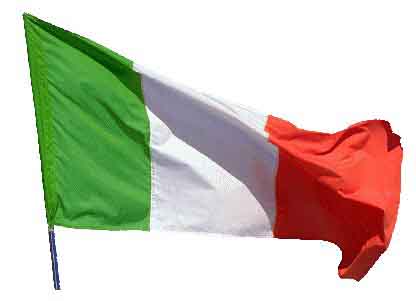

THE FLAG OF ITALY
The Green, White and Red Tre-Colore Flag first flew at Modena in 1797 as the
banner of the Cisalpine Republic. (Located between Parma and Bologna, Modena
is in the Province of
Emilia-Romagna. It is the home of the Ferrari and Maserati auto works).
The new entity began with a brilliant festival in Milano. Its constitution was modeled after that of the French. At that time much of Italy was controlled by the Hapsburg's of Austria – directly and through inter-marriage of the royal families: Milano, Toscana, portions of Genova and Piemonte. The Spanish bourbons held Napoli and Sicilia. The papacy exercised temporal power over the extensive area of central Italia. These were the conditions in 1804 when a Cisalpine deputation went to Paris to solicit Napoleon I to accept the crown of the Kingdom of Italia.
In early 1805, when Napoleon I grouped the Northern Italian provinces into
one kingdom, he also adopted the Tre-Colore Flag. Arriving in Milano accompanied
by Pope Pius VII, on May 26, 1805, Napoleon received the crown of Charlemagne
in the Milano Cathedral. Condensing fifteen states into three, Napoleon leveled
the barriers of local rivalries and brought a good administration –
- an approach to political unity.
Napoleon’s success was short-lived. The Conference at Vienna in 1815 again divided Italia into nine separate states with individual governments. The Austrians still controlled their same territories.
Not until the famous patriot, Giuseppe Mazzini, had successfully stimulated and organized the uprisings of early 1848, was Italia to throw off the yoke of other nations.
The Tre-Colore was again proclaimed the national flag in late 1848 when King
Carlo Alberto, of Piemonte and Sardegna, led the Nationalist force in his effort
to free Italia of outside domination and formed a constitutional monarchy. King
Alberto, of the House of Savoia, added the arms of his royal house to the flag.
His shield displayed a black eagle. The whole was surrounded by the collar of
the
Order of the Most Sacred Annunziata, the third highest in rank of all European
Orders.
Following his landing in Sicilia in 1860, Giuseppe Garibaldi progressively freed most of the country and turned over control to King Vittorio Emmanuele I, the son of King Carlo Alberto.
In 1870 when the Prussians invaded France, Napoleon III found it necessary to withdraw his troops from Roma. With Italia totally liberated, Giuseppe Garibaldi carried the Flag as embellished by the late King Alberto.
Following the death of his father, King Vittorio Emmanuele II, from his capital
in Firenze, added a crown above the Arms and Shield on the Flag. Seizing on
the opportunity of Napoleon’s departure in July 1871, King Vittorio Emmanuele
II entered the Eternal City to the tumultuous cheers of the people.
In 1872, Roma was made the capital of the Kingdom of Italia.
The Arms and Crown were removed from the Flag when Italia became a Republic
in June 1946 returning the Flag’s design to the simple Tre-Colore of Green,
White and Red.